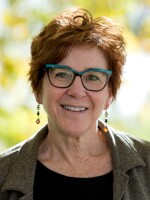This article first appeared in the St. Louis Beacon, July 25, 2012 - Public art defines and dots the St. Louis area.
There’s The Arch, obviously, and “The Way,” Laumeier’s enormous red signature piece. Presiding over downtown’s Citygarden is the headless “Big Suit,” along with “Big White Gloves, Big Four Wheels,” otherwise known as “the Pinocchio sculpture.”
Among the outdoor pieces distinguishing the Washington University campus are a borrowed ode to Rodin, “Thinker on a Rock”; the Kemper Art Museum’s actual Rodin, “The Shade”; and the Kemper’s permanent site-specific outdoor installation, “Accessories to an Event.”
Watch for more public art around campus and more local conversation about public art, following the hiring of a curator for public art in WUSTL's Sam Fox School. Sharing a first name with legendary Sam Fox professor emeritus of architecture Leslie Laskey, Leslie Markle comes to St. Louis as the former director of public art and design for the Long Beach Arts Council.
Markle’s accomplishments there include a portable performance venue for vacant lots and the redevelopment of the city’s downtown promenade, a project that included six permanent art commissions. His previous employment includes a stint as lead artist for Long Beach’s Bus Shelter Project.
In his new WUSTL position, Markle will oversee the university’s Art on Campus initiative, which will pair building and renovation projects with art installations that will join the Kemper’s permanent collection.
The Beacon talked with Markle during his early weeks in St. Louis about the job ahead.
The Beacon: How does Art on Campus work?
Leslie Markle: The Kemper museum has a pretty well-respected art collection of art and outdoor sculpture. The idea with Art on Campus is to commission contemporary artists to integrate art within the built environment at the university.
One percent of any environmental building initiative goes toward art. So it’s part of the capital project with some exceptions; the medical campus is excluded.
Is any specific WUSTL project in progress?
Markle: There are already four projects in the works. We’re just finalizing the artist selection process. The curatorial staff here has been working on those projects prior to my hire.
The school of business has a major expansion -- that’s probably the biggest project, the Olin project. There are a couple of building projects with arts and sciences. Then there’s an off-campus housing project.
How might the WUSTL installations engage the larger community?
Markle: Part of the initiative is to have a dialogue about place-making as part of the wider community of St. Louis. The university is involved in off-campus projects with the Pulitzer Foundation, basically holding programs and having dialogue. And the artworks themselves -- there’s an intention that they’ll promote dialogue, too.
What’s also interesting to me is to be involved in community outreach and to be involved in off-campus programs that foster civic engagement. We had a lot of that kind of programing in Long Beach, aimed at some of the social problems that they face that are not unlike some of the issues here in St. Louis.
In Long Beach, the public art program was primarily funded by the redevelopment agency so we really tried to do temporary programing that complemented the mission of redevelopment, which was to address issues of physical and economic blight. We did a series called the A Lot. We commissioned artists to build a temporary performance venue and we provided programming for the venue and also had educational panels and discussions.
Why is public art important to a city?
Markle: I think it’s a way to create civic identity. That’s one of cliches people say but it's really true. It’s a platform for engaging the public in dialogue and fostering civic engagement, and it serves as a forum for communication and exchange.
For Washington University, it’s about adding that cultural component to environmental building initiatives and also creating a kind of sense of community or the campus.
How much time have you spent here and what’s your impression so far of St. Louis’ cultural and arts scene?
Markle: I was here for a couple of days in early May and then I came back in June to visit after I’d been offered the position. My wife and daughter came with me on the second visit -- she just turned 2 in May.
When I came to interview, Carmon [Colangelo, Sam Fox School dean] took me to the Pulitzer Foundation and to the St. Louis Art Museum.
Long Beach is a fairly large city and it has cultural amenities but I think St. Louis has a really vibrant cultural scene. It is a little bit smaller in terms of the city itself than Long Beach and smaller in population but it has a lot more to offer, culturally. I saw St. Louis as a very arts-friendly city.

